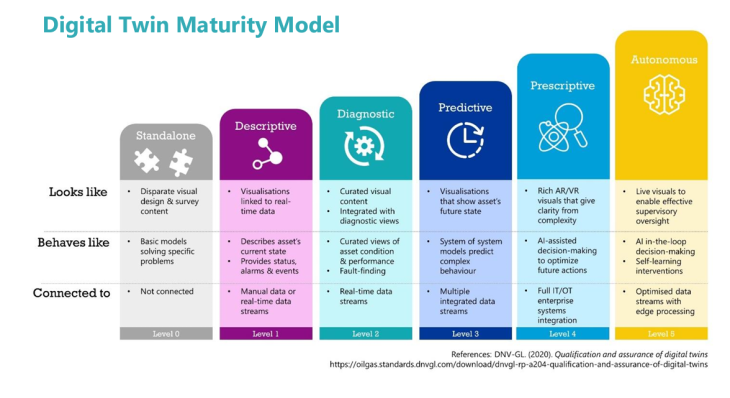Digital Twins and Value Realisation
From hype to value - Delivering on the promise of Digital Twins.
From cities to factories, supply chains to hospitals, Digital Twins are promising to innovate and transform the ways in which organisations operate and make decisions in the future.
Many of the building blocks for Digital Twins aren’t new; operational technology such as sensors and SCADA systems has been around for decades, as have 3D models and simulation tools.
However, the convergence of areas such as increased processing power, advances in artificial intelligence, and the commoditisation of IoT have now generated the right conditions to create Digital Twins that can transform complex and asset intensive businesses.
Beyond the hype and theoretical discussions on ‘the art of the possible’, we are already seeing practical applications for Digital Twins emerge in many industries. We are finding organisations that are successful at unlocking value from a Digital Twin investment typically have three key characteristics in common:
- Digital Twin projects have strong relevance and alignment to the organisation
- The project has been right sized and scaled appropriately.
- Organisational readiness is well understood before the project proceeds.
 |
|
Relevance
It can be easy to get swept up in the slick capabilities and promises of some of the Digital Twin platforms available on the market, however after deployment then find that while it looks impressive, the measurable value it is providing isn’t clear, leading to a loss of confidence and the project stalled.
Rather than thinking of a Digital Twin as being a full-blown replica of your assets, it can help to instead think of it as a tool to support your business processes and your decision making.
This reframes it to a value-based context, rather than focussing on the technical context and capabilities of a Digital Twin. We are already seeing examples where Digital Twins are driving real value, with measurable improvements to process efficiency, cost management, risk management, sustainability, change adoption and many other business functions – however this only occurs when the projects are focussed on relevant areas.
As first step we suggest businesses ask themselves some key questions:
| What business processes do we need to improve? |
| What are the decisions we need to make that we don't have the insights to support |
|
How do these relate to our strategic outcomes, to the drivers of our markets and customers? |
| What are our key pain points and for what people? |
These types of questions can help point the way to the right focus area for a Digital Twin project, such as:
- A maintainer trying to find accurate, up-to-date equipment information
- An operator requiring rapid support from a remote guru
- An engineering manager trying to get the most out of a production line
- An executive wanting a portfolio view to manage risk and investment
- And so on, right across your business.
Looking up and down, left and right across your organisation, thinking about your business processes and decision making and asking these questions, you can uncover and unlock the most relevant areas in your business for a Digital Twin project, one that drives shareholder value and supports you to deliver your strategic goals.
By starting with relevance to a clear business need and alignment to organisational outcomes, you may find your “twin” ends up looking quite different to what you expected – no less shiny, but a lot more relevant.
Right sized
Once you understand the relevant areas of your business for Digital Twins, right sizing both the project delivery and the Digital Twin platform you use is the next crucial step in realising value. There are vast numbers of platforms now available on the market, all with a different definition of what a Digital Twin really is, and all targeted at different industries and domains. At Beca, we use a simple definition being a digital representation that looks like, behaves like, and is connected to the real-world object.
While this provides a relatively straight forward foundation for what a Digital Twin is, each business is different in terms of the elements it actually needs, in order to generate value. We recommend not getting captivated by the all-singing, all-dancing twin, and instead ask yourself – what level of detail do you really need to deliver the value?
While a platform may be capable of getting down to the nuts-and-bolts level, is that important or do you only need to understand the asset as a whole? Do you really need to include all three elements of looks like, behaves like and connected to, right from the start of your project?
Or can these be added later once you have addressed the relevant problem or opportunity?
Breaking down the identified value by understanding the problems that need to be addressed to unlock it, you can right size your Digital Twin project to focus on just what you need, not on everything that is possible. Solving one problem at a time, and solving it well, will make it stick and provide you with the necessary solid foundations to build out your Digital Twin over time.
With these foundations in place, stakeholders will start to develop their own uses cases in their own context – rather than pre-bottled use cases derived from a template. You can also then start to make additional connections between your systems and data, snowballing to the point where you have a fully-fledged Digital Twin supporting multiple people with multiple pain points, delivering continuous value and enabling a process of continual improvement and innovation.
A common challenge is that business information and processes, while often rich, are neither accessible nor contextual. For example, this could include access to the right Standard Operating Procedures or key Health & Safety information. Placing this information in context of a virtual experience (looks like) and linking to your information systems (connected to) can deliver real productivity and safety benefits early. |
Readiness
A common misconception on Digital Twins is thinking of it as a single system or state, when in fact it is a continuum of capabilities that align to a Digital Twin maturity model. Assessing your business readiness will enable you to understand where you currently sit from a maturity perspective, and then in turn establish what a relevant and right sized project could look like, to take you further up the pathway to Digital Twin maturity. 
Key factors to look at when assessing business readiness include:
|
|
Do you already have cross-functional teams working together to identify and realise value, or if not, are teams siloed focusing on a single purpose? For a Digital Twin, it is the connections between the data that drive value, therefore understanding your readiness to establish these connections is important for value realisation |
|
What your current culture of information management is – do you value data as an asset? Have you identified multiple uses for what may be siloed data sets? Information management maturity is an important indicator of business readiness for Digital Twins, and it includes understanding the value of datasets across different aspects of your organisation, and the level of business change that will be required to generate value. |
 How do you do “what if” scenarios and predict the future? This is not always just data scientists and A.I., but how do you bottle up the experience of key people and expand their impact? What processes and systems do you have to prevent knowledge and experience walking out the door? How do you do “what if” scenarios and predict the future? This is not always just data scientists and A.I., but how do you bottle up the experience of key people and expand their impact? What processes and systems do you have to prevent knowledge and experience walking out the door? |
Moving beyond the hypeThe promise of digital twins is substantial, with advances in technology enabling predictive, prescriptive, and autonomous twins to move from the possible to the probable. When taking a first step towards this future, using the critical keys of relevance, rightsizing and readiness can help your organisation to unlock value from digital twins in the here and now. |
Get in touch today
 |
Mari Huusko |
 |
Stephen Witherden |
 Understanding what data you already have, where it is, how it is organised and how accessible it is. This can help you identify potential quick wins, such as surfacing this information to key people faster and with better context.
Understanding what data you already have, where it is, how it is organised and how accessible it is. This can help you identify potential quick wins, such as surfacing this information to key people faster and with better context. 